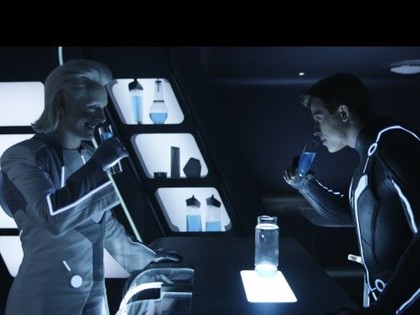The 3D world of Tron: Legacy
"Predominantly, most of the movie occurs behind the scene (in positive parallax). The 3D is meant to be an immersive experience, to pull you into it. But isn't it weird how those vertical shots have that much more effect?" says Kosinski."For some reason, I figured out really early that if you're looking out across a
landscape in 3D it's one thing, but as soon as you get the camera up and look down - even if you have the same 3D settings - it triggers a sense of . . . vertigo. The top down shots have so much more depth to them. So once I realised this, it was fun to look for moments when it made sense to shoot like that."

Keeping it real
The director says that for all Tron Legacy's CG elements, if the 3D was going to work it had to be grounded within actual sets made of glass, concrete and steel, and shot on real cameras. This hyper-reality philosophy extended to the creation of the movie's futuristic vehicles.
"We actually built all the cockpits for the car and the jets," lead Vehicle designer Daniel Simon told Tech Radar, "so that the actors could perfectly interact with everything.
They could sit in the cockpit of the Light Runner (a Grid racer which morphs into an off-roader when needs must), turn the ignition key and have everything light up beautifully; they could turn the wheel and even click the gear shifter. All the rest is 3D graphics. It's so important for the actors to hold onto something; otherwise the onscreen world is just not believable."

2D to 3D conversions
Sign up for breaking news, reviews, opinion, top tech deals, and more.
Despite the complexity of the project, director Joe Kiniski says he never considered shooting Tron Legacy flat and dimensionalising it in post production.
'I'm not a big fan of converted movies, it's just a cheap way out" he tells us, making a clear reference to Clash Of The Titans. "Converted movies often aren't even meant to be done in 3D, they try and convert them after the fact for marketing reasons. Tron Legacy was shot and conceived in 3D, every step of the way."
Ultimately, he believes it's the audiences themselves which will put paid to faux 3D movie conversions. "I think there's a little bit of resistance to converted 2D now.
Audiences are getting savvy; they can tell the difference between a 2D-to-3D conversion and a real 3D movie. This is why I'm trying to get the word out that this film was shot in, and meant to be seen in, 3D." However, the director concedes that the format doesn't "make sense for every movie. It does take more time and money to do it right."

The IMAX cut
Perhaps the ultimate 3D Tron Legacy experience is to be had at Imax cinemas. A larger-than-life special edition of the movie has been produced for these theatres, which combine 3D projection system with the IMAX's larger-than-decent screen size.
"There are seven sequences in this film that have been digitally re-worked for IMAX," reveals Joe. "When you see the movie in an IMAX theatre you're going to get extra image area at the top and bottom of the frame, so that it really fills your vision." The director reveals that the re-rendered IMAX sequences total 43 minutes of the movie's running time.
"We're now talking with Disney about doing an IMAX version on the Blu-ray," confides Kosinski. "If you pick that version, those seven sequences will expand from 2.35:1 to fill your entire television. It should be pretty cool."


Steve has been writing about AV and home cinema since the dawn of time, or more accurately, since the glory days of VHS and Betamax. He has strong opinions on the latest TV technology, Hi-Fi and Blu-ray/media players, and likes nothing better than to crank up his ludicrously powerful home theatre system to binge-watch TV shows.